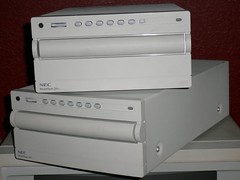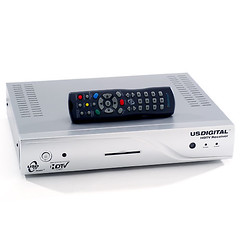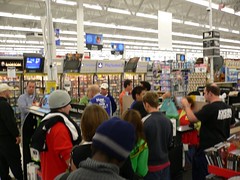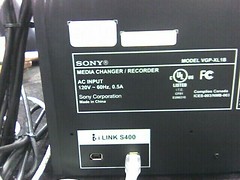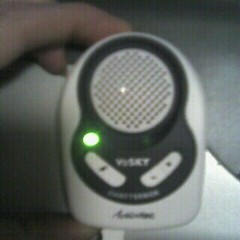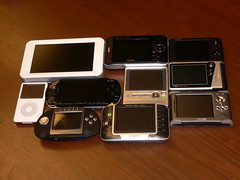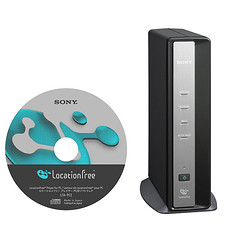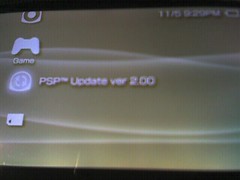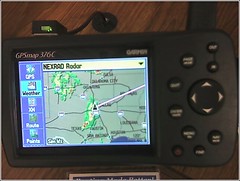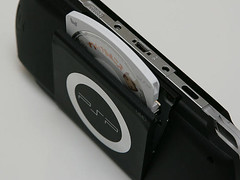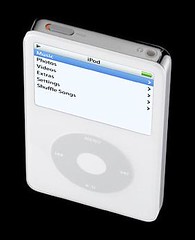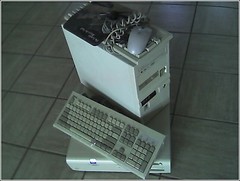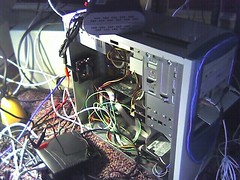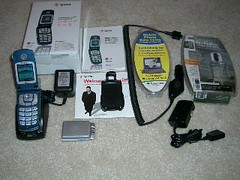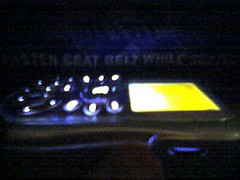Wednesday, November 30, 2005
Media Center wasn't the first with Changer Support
Back in the early 2000 time frame, I used many PC's to simultaneously rip a handful of CDs to MP3 format, so the process didn't take long during evenings that I was home. Five years later, the new Sony X1 Media Center PC and associated VGP-XL1B 200 DVD/CD changer supports a Media Center plug-in to rip 200 CD's at a time, but at a cost of over $2200, it's an expensive proposition. Trying to do this on the cheap, I dug around my house and found some old SCSI NEC 2Xc 7 disc CD changers (just like the Nakamichi's) and went about finding software that supported them. Turns out that iTunes shows the two of them as 14 disc drives, and grabs the CDDB information associated with each disc, but doesn't allow you to rip sequentially.
The solution? Enter the Riptastic! MP3 CD Ripper with multi disc changer support. This thing will even sequentially rip between two single disc players in your PC if you don't have a changer! It grabs the CDDB information and rips along at 1.1x for my SCSI NEC's and faster with some of my other drives. The best thing about this solution is that I no longer have to babysit my computer. I just load up my discs then head about my business. You can pick your compression and bitrate and also the file naming convention. It will also encode simultaneously while ripping, but my 1GHz test machine could stand to be a bit more stout for the encoding process. Does anyone need a hundred or more discs ripped? My hardware is ready, but my music is already on hard drives...
Tuesday, November 29, 2005
Robbing bandwidth from the rich...
The tuner works as an ATSC or high-definition decoder for free but the magic was that in select markets, for a mere $19.95 per month, Fox News, Discovery, Disney and about 30 other "cable" channels can be received. The signals for these channels are broadcast over unused capacity within the HDTV UHF spectrum using technology from DotCast. HDTV frequencies are 6MHz wide and offer 27mbps of throughput. The FCC requires that an HDTV channel use only up to 19.4Mbps of bandwidth so that leaves a bit extra for USDTV to lease and combine with partially used channels over remaining spectrum from each broadcaster in a region. DotCast developed this multiplexing technology to spread data across many channels as a way to download programs to computers or set-top boxes. With USDTV, this "video data" is decoded with an ATI NXT2004 as standard definition video programming from a VSB/QAM tuner. This is sent to the TV by way of a ATI Xilleon chip running at 300MHz, which handles the AC3 and MPEG2 decoding. The only connection that you need to receive their signal is a bow-tie or external UHF antenna. No cable feed or even satellite dish aiming is required. This also means that rain fade should be non-existent as well. All that you need is a strong UHF signal to your home, or an antenna suited for its reception.
This is an interesting concept, as USDTV has created an MVNO model for television. Think about all of the money that your local broadcast networks spend to keep their broadcast towers up and online. An even more expensive undertaking is keeping Murdock and Ergen's DirecTV and DISH Network satellites in a 22,300 mile orbit in space. USDTV can ride on the backs of infrastructure that is already in place and their only cost is customer acquisition and programming. It worked well for Virgin Mobile, Boost and hopefully the just released Amp'd. There are some TV affectionado's who are concerned that HDTV quality will suffer as broadcasters supplement their revenue stream with data casting, but most markets that are using the technology get a majority of their bandwidth from digital networks owned by PAX, which only programs in standard definition - leaving plenty of bandwidth for USDTV. The jury is still out on whether they can be successful in the market place, but with a great channel selection, low cost and inexpensive hardware, they have all of the things going for them including the ability for the end user to "self install." Now that is scalable!
Monday, November 28, 2005
888-ELF What?
Thursday, November 24, 2005
Non Powered Gadgets
Gadgets like the Targus Coolpad, a turntable swivel for your laptop and the Tetran Headphone Holder are $12 smart accessories that just make sense. These problem solvers are cheap and smart - perfect for stocking stuffers or the guy or gal who has everything. Especially if you are on a budget.
So if you are still going to be shopping for the top gadget of the season, keep your eyes peeled for some gems that have no battery slots and that do not plug into the wall. Chances are your gift will be an unexpected suprize hit for the holidays.
Wednesday, November 23, 2005
XBox 360 Launch Part Deux.
Production should not be an issue since they have been making these since the spring. I went to Tokyo 30 days after the launch of the PSP and they were still not available at retail - I had to get mine from a back-ally DVD trader. That contrasts with the spring US launch of 500,000 units sold which were easily obtainable. My local Best Buy had hundreds of units available in stacks with few customers. I even went back the next day to pick up another one. Microsoft has stated that 400,000 360 units were being shipped to the US before Christmas, while these numbers are just shy of the PSP two-day sale quantities, this artificial demand and sales during the "right" selling season should mean that although the XBox will be a sell-out, you will have plenty of units between now and December 25th. I'm headed to Costco to see if I can get one before Black Friday. I bet I will.
Tuesday, November 22, 2005
 "I've got the XBox 360 until 9am Blues......" This happy strumming camper outside of the Grapevine, Texas Best Buy is at the head of the pack for one of their 30 "Premium" $399 allocated systems to be released in the morning. A line stretched across the front of Best Buy to Mattress FIRM, who lost an opportunity to rent mattresses to these young adults. Just around the corner at Wal*Mart, 16 "Core" units were available 9 hours earlier, at midnight. I was lucky #17 in line. If only I didn't return home to get my camera, I too would have one, but with merely a 10 minute check-out wait. That's more my style! At another mid-cities Wal*Mart, 2 units were there until 8 were picked up from UPS by an employee, which had embargoed them until November 22nd. Across town in Addison, two 360's were sold at Wal*Mart and a handful of campers waited at a Best Buy - one had been there for 25 hours already. With 40 degree nights in North Texas, I can't see myself waiting. Further North in Frisco, my friend who left the Addison store arrived at 12:30 to be the 21st person in line out of 16 units available. But why is there such a demand for the device? Is it that the XBox 360 is the nearly the first "true" HDTV capable gaming system. Or is it an artificial demand due to low numbers of product allocation like the PSP had this time last year in Japan, but not during the spring US launch? The console will operate at all high-definition resolutions, albiet using the component analog video connection. A digital HDMI connection is rumored to be released "when Microsoft thinks that the market is ready." My home theater has two HDMI devices and a switching receiver. We are ready MSFT! The console will also make for a nice Media Center Extender to play back stored content in another room. My burning question is will it play back my HD content recorded via my All in Wonder ATSC tuner, or will it ignore that video like my Linksys Media Center Extender. It will never receive DVD's across the link due to DMCA issues but as my library of HDTV content grows, it would be nice to share that around the house - over wired 100MBPS links of course, just like I can with the Roku HD1000. More photos at http://www.flickr.com/photos/gadge/65875289/ from the launch festivities.
"I've got the XBox 360 until 9am Blues......" This happy strumming camper outside of the Grapevine, Texas Best Buy is at the head of the pack for one of their 30 "Premium" $399 allocated systems to be released in the morning. A line stretched across the front of Best Buy to Mattress FIRM, who lost an opportunity to rent mattresses to these young adults. Just around the corner at Wal*Mart, 16 "Core" units were available 9 hours earlier, at midnight. I was lucky #17 in line. If only I didn't return home to get my camera, I too would have one, but with merely a 10 minute check-out wait. That's more my style! At another mid-cities Wal*Mart, 2 units were there until 8 were picked up from UPS by an employee, which had embargoed them until November 22nd. Across town in Addison, two 360's were sold at Wal*Mart and a handful of campers waited at a Best Buy - one had been there for 25 hours already. With 40 degree nights in North Texas, I can't see myself waiting. Further North in Frisco, my friend who left the Addison store arrived at 12:30 to be the 21st person in line out of 16 units available. But why is there such a demand for the device? Is it that the XBox 360 is the nearly the first "true" HDTV capable gaming system. Or is it an artificial demand due to low numbers of product allocation like the PSP had this time last year in Japan, but not during the spring US launch? The console will operate at all high-definition resolutions, albiet using the component analog video connection. A digital HDMI connection is rumored to be released "when Microsoft thinks that the market is ready." My home theater has two HDMI devices and a switching receiver. We are ready MSFT! The console will also make for a nice Media Center Extender to play back stored content in another room. My burning question is will it play back my HD content recorded via my All in Wonder ATSC tuner, or will it ignore that video like my Linksys Media Center Extender. It will never receive DVD's across the link due to DMCA issues but as my library of HDTV content grows, it would be nice to share that around the house - over wired 100MBPS links of course, just like I can with the Roku HD1000. More photos at http://www.flickr.com/photos/gadge/65875289/ from the launch festivities. 
Monday, November 14, 2005
The Return of the Blob
Why congeal water you say? Because in a bath tub that you could soak in, it forms an insulating barrier to hold the heat of the water in longer. And that is way cool. The powder additive contains non-toxic elements to turn the water to jelly as it is absorbed into sodium polyacrylate. Additives that are good for your skin like vitamin C as well as black tea extract, L-menthol, coloring, and fragrance are also mixed within the powder.
The inventor from Kobe Japan filed the patent in February of 2000 (probably after taking a bath that quickly became cold) which was granted relatively quickly in August 2001. The patent #6,281,177 reads like a recipe until you get to the scary claim fifteen, a subordinate of number nine. It reads "gelatinous mixture draws water from human skin immersed in said gelatinous mixture." I may be reading into this, but wasn't something JUST like this a source of a horrifically scary movie from the late 1950's? That's right. Jellybath is The Blob.
I am not getting near this stuff, but if you do, be prepared for a "NOTICE" of the patent before you buy the product online. I guess at $24 dollars per bath they want to keep competition down so that you are the only one who is getting soaked. Just don't forget that you will still need to take a shower afterward. www.jellybath.com
DRM DMCA FireWire and HDCP Blues...
All that being said, I find it odd that Sony, owner of many labels, production companies and media production facilities has begun shipping their latest product to aid in mass-theft, I mean ripping of digital media. The Sony VGP-XL1B 200 CD/DVD/Dual Layer Burner has a FireWire/iLink port to tie into their matching Media Center PC. The Windows XP MCE 2005 Roll-up has new features to let this 200 disc changer literally rip through a majority of your CD collection and digitize them on your hard drive in a single sitting. The dual-layer DVD burner within will copy those tracks back to discs or write your recorded low-definition captured television to a DVD. An empty PCI slot inside will hold an HD tuner which you can record and also burn to DVD (albeit in a low definition, yet clear version) now. Finally, it will use your Internet connection to grab the artwork from up to 200 of your store bought DVD's that you place inside and let you choose a movie by selecting a picture from the assortment displayed within the Media Center Interface.
Two features are missing in my opinion, due to DRM, which may be able to be "patched" with a program like DVD43 or AnyDVD. You cannot play your DVD's through Media Center Extender devices and thanks to Content-Scrambling System or CSS you cannot rip your DVDs to the hard drive. Now at an average of 6GB per DVD, ripping movies would take 100 times more space than ripping an audio CD. But that is using MPEG2; DivX or MPEG4 would take much less space and make the content much more portable.
I think that you should be able to put the movies that you buy on any device or television around your house. I have all of my music CDs encoded into MP3 and they can be played in any room in my house. My whole house audio system is my most used gadget in my life. Video, however stays on DVDs in a shelf until I get up, choose, and insert them into one of a half-dozen players in my home. I wish that it was digitized like my music was. I want my DVDs to be seen anywhere. Throw a watermark in the video to track the serial number of the device that encoded it and make the people who do bad things pay for their crimes of distribution. If I want to make a copy for my own fair use on another device I own, like the Sony PSP then let me!
As I close this, did you notice anything unique about the photo above? The DVD player only has a single connection, even better, it is a high quality digital port. A port that pushes video and audio in the clear, FireWire. That's right, no encryption means that we may soon see FireWire CSS strippers just like devices that would remove Macrovision from composite signals to allow you to make VHS copies of your video tapes or DVDs. If this 200 disc changer is the hackers dream, sign me up for the 400 disc version. I have some fair use to get to.
Tuesday, November 08, 2005
VoSKY Chatterbox
10 Video Playback Devices
Apple beat Sony at the portable music game because of CODECs (compression) first and design second. Sony's digital players required that you CHANGE your MP3 music into ATRAC format up until September 2004. This relatively unknown compression was a carryover from their 1993 MiniDisc technology. Meanwhile Apple's PortalPlayer designed iPod could play 7 different audio formats. This meant the music that the early adoptors had already placed on their hard drives required no more than a copy to the iPod hard drive - no re-encoding or time consuming step was necessary.
Once the early adopters like something they become the gorilla spokespeople on the street pushing the best technology to their peers. The Apple led design made them easy to look at after the technology made them easy to listen to. Video players have a difficult battle as digitized content is wrapped in Digital Rights Management, or DRM that is difficult, if not illegal to break. DVD's employ Content Scrambling System or CSS, which under The Digital Millennium Copyright Act of 1998 (warning: PDF link) makes it illegal sell ripping software which "breaks" this. That means you cannot play the DVD that YOU bought on a different piece of hardware which may not have a DVD player embedded. On top of this, the different portable playback devices, ten of which are shown above, all support different processor speeds, CODECs (technically just the decoders) and screen resolutions.
What are you to do? Sony and Apple want to make it "easy" by providing a closed system that will let you convert content that you create into video for the PSP and iPod with video. Forget about putting your DVD movies on those devices without jumping through a multi-step process. There are third-party programs that will re-compress multimedia content like DivX, but these applications do not speak portable device language however.
Enter Diversified Multimedia - the company that created the once popular, but now illegal DVD X Copy that was taken off the market from court orders in the spring of 2004. This sharp team of programmers has regrouped to create software that manages your audio, video and photos residing on your computer hard drive, with the necessary encoder CODECs to make this content palatable for your mobile devices. Their Media Vault software to converts any number of different compression formats into any number of mobile device resolutions.
The best part about this software, which gives it true utility, is that as your devices get upgraded, you can add modules to the software to support your new devices. So your Treo 650 can play back your library today and the currently un-released Treo 700 with its different screen resolution and CODEC can display old or new content in the future. These guys have created the missing link between movies and TV shows stored on Media Center PC's and TiVo's. No longer will you be beaten by a CODEC. Information wants to be free, and mobile.
http://www.divmm.com/ - Diversified Multimedia
Monday, November 07, 2005
How to watch TV - from outside your house.
Location Free TV
Sing Media
Orb Networks
Sunday, November 06, 2005
PSP UMD game forced upgrade
Monday, October 31, 2005
Garmin GPSmap 376c
The integration of GPS mapping and satellite delivered data can bring you real-time re-routing to our car navigation system, ala XM NavTraffic on some Acura and Cadillac vehicles, as long as the traffic data collection is supported in your city. Boaters and aftermarket GPS fans can use the GPSmap 376c from Garmin to display weather overlays on their current map. A 3.8" 480 X 320 256 color screen looks crisp and bright, a battery gives between 4 and 15 hours of use and this, of course, tunes in all 150 channels of XM satellite radio. Radio will cost you $12.95 a month, but weather data, a whopping $29.99 to $49.99 per month. Looks like weather needs a better service model from XM, like NavTraffic which is only an additional $3.99/month for existing radio subscribers. It does however look to be a nice convergence piece of satellite technologies. Plus you could even spill your boat drink on it as it is water restant. Now available at your favorite boat store or online retailer for $800 to $1000.
http://www.garmin.com/products/gpsmap376c/ - For boaters
If you are more of a driver than a boater, the 7" widescreen 16:9 480 x 234 pixel Street Pilot 7200 gives you traffic updates via ClearChannel's or XM NavTraffic service plus weather information albiet more limited than the marine version above. In addition to XM satellite radio, Audible book and MP3 playback adorne this in-vehicle GPS and an SD slot gives you the storage capacity for multimedia and map updates. An integrated FM modulator eliminates the wire between the display and your head unit for stereo audio playback. Look for this unit in December at streeet prices of $1000 to $1200.
http://www.garmin.com/products/sp7200/ - For drivers
Wednesday, October 26, 2005
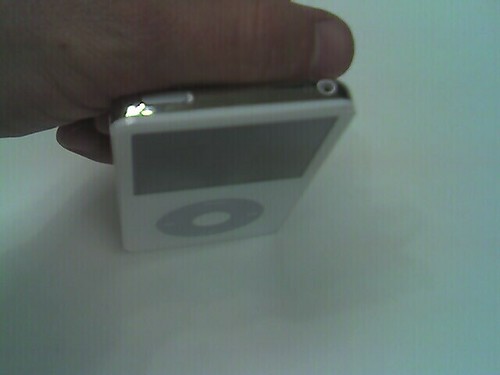 The Apple iPod gave us so much, now it taketh away. Gone from the top of the 5th Generation iPod is the remote control port that few probably used anyway. The real travesty is that this port also provided power for accessories like the Griffin iTrip FM modulator and iTalk voice recorder. Watch for replacements to these in "sled" form factor that connect to the bottom port to derrive power and line-level audio. This should not have the distortion problems that the headphone jack was prone to in the past.
The Apple iPod gave us so much, now it taketh away. Gone from the top of the 5th Generation iPod is the remote control port that few probably used anyway. The real travesty is that this port also provided power for accessories like the Griffin iTrip FM modulator and iTalk voice recorder. Watch for replacements to these in "sled" form factor that connect to the bottom port to derrive power and line-level audio. This should not have the distortion problems that the headphone jack was prone to in the past.The real interesting feature deletion from this iPod though, is its lack of Firewire. Yes Apple, who helped to create this standard has orphaned the technology on thier latest incarnation of the Nano and iPod with Video. That's right, the entire iPod line for fall 2005 only supports USB 1.1 and 2.0. Was this a way to save a few precious cents at manufacturing or is this a testament that there are much more PC than Apple users now? I say the latter as most iMac and iBook users do not have the opportunity to put PCI 2.0 cards in their computers. Perhaps this is just a creative way for Apple to force computer upgrades rather than their throwing in the towel on the technology. Expect slightly longer charge times and slower speeds in syncing with USB 2.0 over Firewire also called IEEE 1394.
Thursday, October 13, 2005
Video on the iPod vs the PSP
The iPod won the war of the pocket music players against Sony, the inventor of the portable music category, from their Walkman and Discman players in the 1980's. Apple beat them from their 30 year monopoly because the iPod supported 7 different compressed media formats versus Sony's single ATRAC codec, a carry over from their MiniDisc technology they pushed into their "MP3" player lineup. It was not until Fall of 2004 that Sony announced MP3 support, well after the device game was lost. In 2005, they began shipping laptops with SD and Memory Stick ports - a further shift towards supporting standards other than their own.
Lets look at the specifications of the Sony PSP vs. the iPod 5th generation video player.
Sony PSP:
Overall device size: 6.7 x 2.9 x .9 inches
Video formats via "UMD": H.264/MPEG-4 AVC Main Profile Level3
Video formats via "Memory Stick": MPEG-4 SP,AAC
Output via 4.3" 16:9 TFT
480 x 272 pixel, 16.77 million colors (130,560 pixels)
Content via Sony Connect or retail UMD movies
Create your own via Image Converter 2 Plus for $14.99
Storage capacity: 2GB or 10 hours via Memory Stick Duo or unlimited via UMD media
Battery: 2-3 Hours
iPod 5th Gen:
Overall device size: 4.1 x 2.4 x 0.43 inches
Video formats: H.264 video: up to 768 Kbps, 320 x 240, 30 frames per sec., Baseline Profile up to Level 1.3 with AAC-LC up to 160 Kbps, 48 Khz, stereo audio in .m4v, .mp4 and .mov file formats
MPEG-4 video: up to 2.5 mbps, 480 x 480, 30 frames per sec., Simple Profile with AAC-LC up to 160 Kbps, 48 Khz, stereo audio in .m4v, .mp4 and .mov file formats
Output via 2.5" 4:3 TFT and RCA Composite output
320 x 240 pixel 16.7 million colors (76,800 pixels)
Content via iTunes Music (and Video) store
Create your own via Quicktime 7 Pro for $29.99
Storage capacity: 60GB or 150 Hours of video (max)
Battery: 2-3 Hours
The iPod is clearly smaller, but the screen is nearly half the resolution of the PSP. Remove its wide screen capabilities and you are going to need to get your eyes close to the iPod to see detail in videos. There is a psychological difference to these devices too. The iPod is known as a "passive" listening device where the PSP is an "active" engaging product. We have to engage to watch TV or play games so the iPod's video capabilities may go forgotten after the novelty wears off or the time to download content into iTunes then transfer it from your computer to the iPod makes us weary. If users have large music collections, the tradoffs between many songs being replaced by only a handful of TV programs may be another detriment.
Sony has their Connect download service and many UMD movies in retail stores while Apple has no movie program because of digital rights issues from the DMCA and only a few "formerly free" broadcast TV programs and some music videos available to purchase. I predict that it is only a matter of time before Pixar and Disney movies are available on the iTunes service, with the other studios to follow. Downloading a 2+ hour movie will be extremely time consuming and expensive for both a time and cost of bandwidth standpoint.
Both Sony and Apple offer software programs to convert home movies or TV programs that reside on your PC hard drive into MPEG4 formats compatible with their devices. Unfortunately, as easy as it is to rip your audio CDs to MP3 format, neither of these will allow you to "rip" a DVD that you own onto the devices although third-party "hacks" will let you achieve this with a few extra steps.
Now Apple does support a TV output and even an optional $39 remote control which makes this a neat "pocket PVR" for your television at home or on the road. Today, at the launch of the 5th gen iPod, I say the PSP wins at video and the iPod wins at music. These tables could change however, if Apple buys TiVo and enables their PC Home Media Option or rear USB ports to sync between the two formerly disparaged devices. An iPod that "talks" to a TiVo would be one of the few killer convergence devices. If you think about it, both Apple and TiVo have nailed the perfect consumer experience. Sony is playing catch-up.
Video on the iPod vs the PSP
The iPod won the war of the pocket music players against Sony, the inventor of the portable music category, from their Walkman and Discman players in the 1980's. Apple beat them from their 30 year monopoly because the iPod supported 7 different compressed media formats versus Sony's single ATRAC codec, a carry over from their MiniDisc technology they pushed into their "MP3" player lineup. It was not until Fall of 2004 that Sony announced MP3 support, well after the device game was lost. In 2005, they began shipping laptops with SD and Memory Stick ports - a further shift towards supporting standards other than their own.
Lets look at the specifications of the Sony PSP vs. the iPod 5th generation video player.
Sony PSP:
Overall device size: 6.7 x 2.9 x .9 inches
Video formats via "UMD": H.264/MPEG-4 AVC Main Profile Level3
Video formats via "Memory Stick": MPEG-4 SP,AAC
Output via 4.3" 16:9 TFT
480 x 272 pixel, 16.77 million colors (130,560 pixels)
Content via Sony Connect or retail UMD movies
Create your own via Image Converter 2 Plus for $14.99
Storage capacity: 2GB or 10 hours via Memory Stick Duo or unlimited via UMD media
Battery: 2-3 Hours
iPod 5th Gen:
Overall device size: 4.1 x 2.4 x 0.43 inches
Video formats: H.264 video: up to 768 Kbps, 320 x 240, 30 frames per sec., Baseline Profile up to Level 1.3 with AAC-LC up to 160 Kbps, 48 Khz, stereo audio in .m4v, .mp4 and .mov file formats
MPEG-4 video: up to 2.5 mbps, 480 x 480, 30 frames per sec., Simple Profile with AAC-LC up to 160 Kbps, 48 Khz, stereo audio in .m4v, .mp4 and .mov file formats
Output via 2.5" 4:3 TFT and RCA Composite output
320 x 240 pixel 16.7 million colors (76,800 pixels)
Content via iTunes Music (and Video) store
Create your own via Quicktime 7 Pro for $29.99
Storage capacity: 60GB or 150 Hours of video (max)
Battery: 2-3 Hours
The iPod is clearly smaller, but the screen is nearly half the resolution of the PSP. Remove its wide screen capabilities and you are going to need to get your eyes close to the iPod to see detail in videos. There is a psychological difference to these devices too. The iPod is known as a "passive" listening device where the PSP is an "active" engaging product. We have to engage to watch TV or play games so the iPod's video capabilities may go forgotten after the novelty wears off or the time to download content into iTunes then transfer it from your computer to the iPod makes us weary. If users have large music collections, the tradoffs between many songs being replaced by only a handful of TV programs may be another detriment.
Sony has their Connect download service and many UMD movies in retail stores while Apple has no movie program because of digital rights issues from the DMCA and only a few "formerly free" broadcast TV programs and some music videos available to purchase. I predict that it is only a matter of time before Pixar and Disney movies are available on the iTunes service, with the other studios to follow. Downloading a 2+ hour movie will be extremely time consuming and expensive for both a time and cost of bandwidth standpoint.
Both Sony and Apple offer software programs to convert home movies or TV programs that reside on your PC hard drive into MPEG4 formats compatible with their devices. Unfortunately, as easy as it is to rip your audio CDs to MP3 format, neither of these will allow you to "rip" a DVD that you own onto the devices although third-party "hacks" will let you achieve this with a few extra steps.
Now Apple does support a TV output and even an optional $39 remote control which makes this a neat "pocket PVR" for your television at home or on the road. Today, at the launch of the 5th gen iPod, I say the PSP wins at video and the iPod wins at music. These tables could change however, if Apple buys TiVo and enables their PC Home Media Option or rear USB ports to sync between the two formerly disparaged devices. An iPod that "talks" to a TiVo would be one of the few killer convergence devices. If you think about it, both Apple and TiVo have nailed the perfect consumer experience. Sony is playing catch-up.
5th Generation iPod Top View
The bottom connector stayed the same, so your speakers from Altec Lansing, JBL and even the new iHome iPod alarm clock (which sounds GREAT! for $99!) will work with this new portable player.
I was also suprized that they did not include the Bluetooth stereo profile (A2DP) for wireless headphones. This is also unfortunately disabled in the Motorola ROKR phone as well.
Wednesday, October 12, 2005
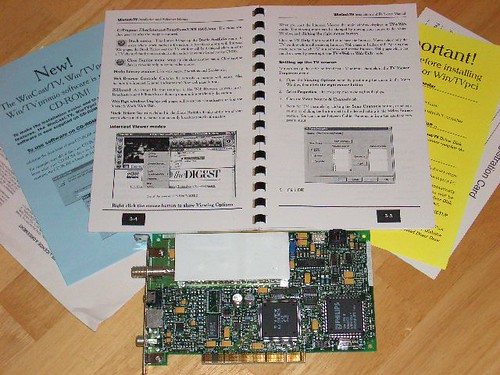
Since the Intel Intercast boards of 1995 I have been fascinated with the convergence of PCs and Television sets. This path, however takes two routes which I have been known to call push and pull. Windows 95 brought TV tuner cards (that actually worked) to the den and WebTV boxes, now called MSN TV, extended PC like functions to living room. Both of these examples are a pull or consuming activity. My Apple computers and now with the stability of XP, my Windows machines let me manipulate and encode digital video from photo and movie cameras, recorded media or live TV. My TiVo content can now live on my huge PC hard drives and be further compressed to resolutions and compression rates more suited to portable devices. Services like Google Video will host my old television shows and even let me charge for them if I wish - ala iTunes. The problem at hand is Digital Rights Management or that bad three letter word that techies call DRM. Now I understand what it costs to produce content. I'm a writer, producer and content creator by trade. I get paid for disseminating what is in my head and putting it in the media. However, I believe as the content becomes available to more people in an easy manner, it gains value. Just as the original swapping of bootleg concert tapes, and now MP3 files help build fan communities for new and established bands, I hope that media content can be aggregated and live on in the new world of TelePixels. Whether it is to extend brand or reach, or become a click and view micro-payment model. The days of the network are dying. I do not watch networks. I watch shows. Networks are ineffecient, difficult to navigate and slow. It is time to trim the fat. This blog will investigate the world of TelePixels, or multimedia content on personal electronics.
Thursday, September 08, 2005
We need your old PCs!
Sunday, September 04, 2005
The animals are hurting with Katrina too.
Most cats did not survive as they are not good swimmers; few made it out of homes and into trees. Many dogs were tied in their yards and perished in the rush of water. Those that were able to swim are missing patches of fur and have cuts from the debris.
If you are missing or have found a pet, you can send a description of the pet including its name and breed to the ASCPA at: [email protected]
One of the few AP stories shows a grim look at the state of animals in the region.
AP Story on Snowball and other pets with a more grim outlook.
Please dontate your time or money NOW: Donate here!
Saturday, August 20, 2005
Distributed Audio over Power Line - AOP
Tuesday, June 21, 2005
Before the Treo 650 and Bluetooth DUN, my data phone solution required lots of cables.
The Sidekick and Treo 600 were the first smart phones that you could really use data on without going insane and I replaced both of these in my pockets with a Treo 650. Since many of us in America have not used Bluetooth for dial up networking I put a little how-to together for Make to get you over the tricky parts.
This solution also works for GSM phones pending that you get the correct dial-up number and login information from your carrier. Before the 650, I used this setup with the very rare CDMA Sony Ericsson T608 which had the worst firmware (SLOW and buggy) that I have ever seen on a phone.
Enjoy the story. Let me know if you want a Mac version too. It's a little easier and almost self explanitory from the PC. Go figure eh?
Follow more at the link.
HowTo Treo 650 Bluetooth Dial-up Networking
TrackBack URL for this entry: http://admin.makezine.com/mt/trackback/811
Tuesday, May 31, 2005
High Altitude XM Radio via the MyFi
Friday, May 27, 2005
Starting with Grey Matter on my site was cute, but I do not have the time to keep up with the comment spammers and deleting their rubbish. Ben and Mena's TypePad based on their Movable Type engine is cool, but I found myself not wanting to pay the $80 a year for that service. Maybe the $50 version would suit me well with the level of features that I would use.
In the mean time, I'll give this service from Blogger another go! Maybe it's worth being different from the rest of the MT crowd.
Dave
